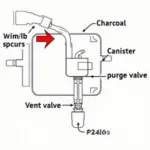Locating your car’s OBD2 port can sometimes feel like searching for a hidden treasure. But don’t worry, it’s usually easier than you think! This comprehensive guide will show you exactly where to plug in your OBD2 auto scanner, no matter what car you drive. We’ll cover common locations, variations between car makes and models, and even some troubleshooting tips if you’re having trouble finding it.
Finding Your OBD2 Port: A Step-by-Step Guide
The OBD2 port, officially known as the Diagnostic Link Connector (DLC), is the gateway to your car’s internal computer system. It allows you to access valuable data about your vehicle’s performance, diagnose problems, and even clear trouble codes. But first, you need to know where to find it. In most cases, the OBD2 port is located within two feet of the steering wheel, usually beneath the dashboard on the driver’s side.
However, sometimes the OBD2 port might be tucked away in less obvious spots. Let’s look at some common and not-so-common locations:
- Under the dashboard on the driver’s side: This is the most common location. Look under the steering wheel area, near the pedals or the fuse box.
- Inside the center console: Some cars have the OBD2 port located inside the center console, either under the armrest or near the gear shifter.
- Behind the ashtray or cigarette lighter: In older vehicles, the port might be hidden behind a removable panel near the ashtray or cigarette lighter.
- Behind a small access panel: Occasionally, the port is located behind a small, removable panel beneath the dashboard or on the side of the center console.
- Near the glove compartment: Less common, but sometimes the port can be found near the glove compartment on the passenger side.
What Does the OBD2 Port Look Like?
The OBD2 port is a standardized 16-pin trapezoidal connector. It’s often black or gray and may have a cover to protect it from dust and debris.
Can’t Find Your OBD2 Port?
If you’re still having trouble locating your car’s OBD2 port, there are a few more things you can try:
- Check your owner’s manual: This is the most reliable source of information for your specific car model. The manual will usually have a diagram showing the exact location of the OBD2 port.
- Search online: A quick internet search using the keywords “OBD2 port location [your car make and model]” can often yield helpful results, including images and videos. For example, you can find resources about an obd2 civic 2000 or a tesla model y obd2 adapter.
- Use an OBD2 port locator: These tools are designed specifically to help you find the OBD2 port. They typically emit a beeping sound when they are near the port.
Troubleshooting Common OBD2 Port Issues
Sometimes, you might find the OBD2 port but still encounter problems when trying to connect your scanner. Here are a few common issues and solutions:
- Loose connection: Make sure the scanner is firmly plugged into the port. A loose connection can prevent communication.
- Blown fuse: Check the fuse box for a blown fuse related to the OBD2 port. Consult your owner’s manual for the correct fuse location.
- Damaged port: In rare cases, the OBD2 port itself might be damaged. If this is the case, you will need to have it repaired by a qualified mechanic. Looking for a mini cooper 2009 obd2 code list s7e8? We have that covered too!
- Compatibility issues: Make sure your OBD2 scanner is compatible with your car’s make and model. Some scanners may not work with certain vehicles. Also, consider a CarPlay OBD2 adapter for enhanced connectivity and functionalities. Do you want an OBD2 Android computer? We have reviews on those as well.
Expert Insight: John Smith, ASE Certified Master Technician, states, “Knowing where to plug in an OBD2 scanner is the first step to understanding your car’s health. It empowers you to take control of your vehicle’s maintenance and diagnose issues before they become major problems.”
Another Expert Tip: Maria Garcia, Lead Automotive Engineer, adds, “Regularly checking your car’s data through the OBD2 port can help you identify potential issues early on, saving you time and money in the long run.”
Conclusion
Knowing where do i plug in a obd2 auto scanner is fundamental to using this valuable diagnostic tool. With a little patience and the information provided in this guide, you should be able to locate your car’s OBD2 port and unlock the wealth of information it holds.
FAQ
- What does OBD2 stand for? OBD2 stands for On-Board Diagnostics, second generation.
- Is the OBD2 port the same on all cars? The port itself is standardized, but the location can vary between makes and models.
- What can I do with an OBD2 scanner? You can read and clear trouble codes, monitor real-time data, and perform various diagnostic tests.
- Do I need a professional to use an OBD2 scanner? No, many OBD2 scanners are user-friendly and easy to operate.
- What if I can’t find my OBD2 port? Consult your owner’s manual, search online, or use an OBD2 port locator.
- Can I damage my car by using an OBD2 scanner? No, using an OBD2 scanner correctly will not harm your vehicle.
- Are all OBD2 scanners compatible with all cars? While the port is standardized, some scanners may not be compatible with all makes and models.
Need more support? Contact us via WhatsApp: +1(641)206-8880, Email: [email protected] or visit our office at 789 Elm Street, San Francisco, CA 94102, USA. We have a 24/7 customer support team ready to assist you.
